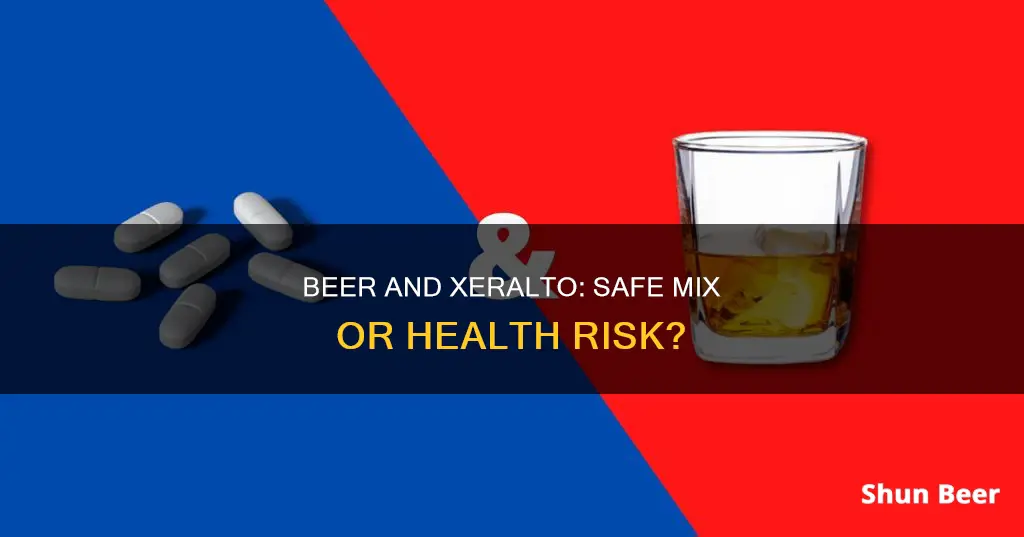
Xarelto is a blood thinner that works by blocking Factor Xa in the blood clotting process. It is used to treat and prevent blood clots that are related to certain conditions involving the heart and blood vessels. While the official line from the manufacturers is that patients do not need to change their dietary habits while taking this drug, healthcare professionals recommend against alcohol consumption with Xarelto. This is because alcohol also acts as a blood thinner, and so the combination of the two may result in intensified anticoagulant activity and a higher risk of bleeding problems. While occasional drinking with Xarelto does not put you at significant risk, exceeding the recommended guidelines for alcohol consumption is considered heavy drinking, and may result in extreme blood-thinning.
| Characteristics | Values |
|---|---|
| Can I drink beer while taking Xarelto? | It is not recommended to drink alcohol while taking Xarelto, as both substances are blood thinners and can cause excessive bleeding. However, occasional light to moderate drinking may be permissible with a doctor's consultation. |
| Risks of drinking alcohol while taking Xarelto | Excessive bleeding, including frequent nosebleeds, prolonged bleeding from cuts, heavier menstrual bleeding, and bruising. May also increase the risk of falls, trauma, accidents, and stroke. |
| Safe amount of alcohol to consume with Xarelto | According to guidelines, moderate drinking is up to one drink per day for women and up to two drinks per day for men. |
What You'll Learn
- Xarelto and alcohol are both blood thinners, increasing the risk of bleeding
- Excessive drinking can lead to liver damage and affect Xarelto's breakdown
- Alcohol may increase the risk of falls and accidents, which could be fatal when on Xarelto
- Light to moderate drinking might be permissible with a doctor's consultation
- Xarelto may cause side effects such as dizziness, fatigue, and stomach pain, which can be worsened by alcohol

Xarelto and alcohol are both blood thinners, increasing the risk of bleeding
Xarelto (rivaroxaban) is a prescription blood thinner used to prevent and treat blood clots. It works by blocking an enzyme called Factor Xa, which is needed for blood clotting. By reducing the blood's ability to clot, Xarelto lowers the risk of stroke, deep vein thrombosis (DVT), pulmonary embolism (PE), and other similar conditions that could become fatal.
Alcohol, or ethanol, is a substance found in beer, wine, and liquor. Clinical studies have shown that alcohol also has blood-thinning properties. It does so by reducing levels of fibrinogen, a protein involved in blood clotting. Research has found that high levels of alcohol consumption, or around two to three drinks per day, reduced fibrinogen levels by 14%.
When Xarelto and alcohol are combined, they can dangerously enhance each other's blood-thinning effects. This can lead to an increased risk of bleeding problems, ranging from minor bleeding such as nosebleeds and bruising to more severe and life-threatening bleeding events. For example, when taken together, Xarelto and alcohol may cause symptoms such as coughing up blood, blood in the stool or urine, and heavier-than-normal menstrual bleeding.
Additionally, the liver is responsible for breaking down both Xarelto and alcohol. However, when alcohol is present, the liver may prioritise breaking it down over processing Xarelto, leading to excess amounts of Xarelto in the bloodstream, further increasing the risk of bleeding.
While occasional light to moderate drinking may be permissible for some individuals taking Xarelto, it is generally advised to avoid alcohol while on this medication. It is crucial to consult a doctor to understand your specific bleeding risks and whether it is safe for you to consume alcohol while taking Xarelto.
Freezing Beer: Safe to Drink After Thawing?
You may want to see also

Excessive drinking can lead to liver damage and affect Xarelto's breakdown
Excessive drinking can lead to liver damage, which can, in turn, affect the breakdown of Xarelto in the body. Xarelto is a blood-thinning medication that is processed by the liver. While light to moderate drinking may be permissible for people taking Xarelto, excessive alcohol consumption can damage the liver over time and lead to problems with blood clotting.
The liver plays a crucial role in the blood clotting process, producing most of the proteins needed for clots. When the liver is damaged, it may not be able to effectively break down Xarelto, leading to excess amounts of the drug in the bloodstream. This can increase the risk of bleeding, which is a known side effect of Xarelto.
In addition to increasing the risk of bleeding, excessive drinking can also worsen other side effects of Xarelto, such as dizziness, fatigue, and stomach pain. It can also exacerbate insomnia, anxiety, and depression, which have been rarely reported as side effects of the drug.
It is important to note that both Xarelto and alcohol thin the blood, and when combined, they can enhance each other's effects. This can further increase the risk of bleeding problems. Therefore, it is generally advised to avoid alcohol while taking Xarelto or other blood thinners. However, if you are taking Xarelto and wish to consume alcohol, it is important to consult your doctor to understand your specific risks and safe drinking limits.
Hindus and Beer: What's the Religious Stance?
You may want to see also

Alcohol may increase the risk of falls and accidents, which could be fatal when on Xarelto
Alcohol consumption while taking Xarelto can increase the risk of falls, trauma, and accidents, which could be fatal. This is because Xarelto is a blood thinner, and so is alcohol. When combined, they can cause excessive thinning of the blood, which can lead to life-threatening bleeding. Even a minor bleeding accident can be fatal for a person taking Xarelto, as there is no antidote to reverse the effects of the drug.
Xarelto is a prescription drug used to prevent blood clots and heart dysrhythmia. It is marketed as a simple and convenient medication because it does not require dietary restrictions or continuous blood testing to adjust the dosage. However, it is important to note that alcohol consumption can be dangerous for patients using blood thinners like Xarelto.
Research has shown that alcohol can act as a blood thinner by reducing the levels of fibrinogen, a protein needed for blood clotting. A study found that fibrinogen levels decreased by 14% in people who drank one to three alcoholic drinks per day. This means that drinking alcohol while taking Xarelto can lead to unwanted and life-threatening bleeding.
The side effects of combining Xarelto and alcohol include frequent nosebleeds, prolonged bleeding from cuts or wounds, increased risk of bloody urine or stool, coughing up blood, heavier than normal menstrual flow, and bruising more easily. Life-threatening bleeding can also occur, such as hemorrhaging, which can be fatal for those with a higher risk of stroke.
It is important to note that the liver breaks down both Xarelto and alcohol, but not necessarily at the same time. When you drink alcohol, your liver may prioritise breaking it down instead of processing Xarelto. This can lead to excess amounts of Xarelto in your bloodstream, further increasing your risk of bleeding.
In conclusion, while it may be tempting to have a drink while taking Xarelto, it is important to consider the potential risks. Alcohol can increase the risk of falls, accidents, and trauma, which could be fatal when combined with Xarelto due to the increased risk of uncontrollable bleeding. It is always best to consult with your doctor about your specific bleeding risks and to follow their recommendations regarding alcohol consumption while taking this medication.
Beer and Coffee: A Safe Mix?
You may want to see also

Light to moderate drinking might be permissible with a doctor's consultation
Xarelto (rivaroxaban) is a prescription blood thinner used to treat and prevent blood clots. It is marketed as a simple and convenient drug that does not require dietary changes. However, when it comes to alcohol consumption, caution is advised.
Both Xarelto and alcohol are blood thinners that affect the blood-clotting process. Alcohol consumption, especially in high quantities, can intensify the anticoagulant activity of Xarelto, increasing the risk of minor to major bleeding problems. Even occasional drinking can cause internal haemorrhages, while heavier drinking may increase the risk of both bleeding and blood clots.
While the official line from the Xarelto website and the FDA is that patients do not need to change their dietary habits, healthcare professionals recommend avoiding alcohol consumption with Xarelto. The absence of an explicit warning against drinking alcohol on the Xarelto label may give the impression that it is safe to consume alcohol while taking this medication. However, the combination of Xarelto and alcohol can be dangerous, and even a minor bleeding incident can be life-threatening.
If you are taking Xarelto and considering drinking alcohol, it is crucial to consult your doctor. Light to moderate drinking might be permissible with a doctor's consultation. According to The U.S. Dietary Guidelines for American adults, moderate drinking is defined as up to one drink per day for women and up to two drinks per day for men. It is important to note that exceeding these guidelines is considered heavy drinking, which may result in extreme blood thinning due to the combined effect of Xarelto and alcohol.
Additionally, alcohol can increase the risk of falls, trauma, and accidents, which could be life-threatening for individuals taking Xarelto due to the lack of an antidote to reverse its anticoagulant effects. Therefore, it is generally advised to avoid alcohol while taking Xarelto to minimise the risk of severe bleeding problems.
Mixing Beer and Whisky: A Dangerous Cocktail?
You may want to see also

Xarelto may cause side effects such as dizziness, fatigue, and stomach pain, which can be worsened by alcohol
Xarelto (rivaroxaban) is a prescription blood thinner used to prevent and treat blood clots. It is designed to lower the risk of strokes, deep vein thrombosis (DVT), and pulmonary embolism (PE), among other similar conditions. It works by blocking an enzyme needed for blood clotting called Factor Xa.
While Xarelto is a convenient and simple drug to take, with no dietary restrictions, it is important to understand its potential side effects and interactions with other substances, such as alcohol.
Xarelto may cause side effects such as dizziness, fatigue, and stomach pain. These side effects can be worsened by alcohol consumption. Alcohol, or ethanol, is a substance found in beer, wine, and liquor. It acts as a blood thinner by reducing the levels of fibrinogen, a protein involved in blood clotting. When combined with Xarelto, which also inhibits blood clotting, the risk of bleeding increases. This is because both substances enhance each other's blood-thinning effects.
The combination of Xarelto and alcohol can lead to minor bleeding problems, such as frequent nosebleeds, bleeding gums, and prolonged bleeding from cuts or wounds. However, more severe bleeding events can also occur, including coughing up blood, blood in the stool or urine, and heavier-than-normal menstrual bleeding. Additionally, the risk of bruising may increase, and internal bleeding can be life-threatening as it is challenging to detect.
The liver is responsible for breaking down both Xarelto and alcohol. However, when alcohol is present, the liver may prioritize processing it over Xarelto, leading to higher levels of Xarelto in the bloodstream, further increasing the risk of bleeding. Chronic alcohol use can also lead to liver damage, which can impact the liver's ability to process Xarelto effectively and increase the likelihood of bleeding complications.
Therefore, while occasional drinking in moderation may be permissible with a doctor's guidance, it is generally advised to avoid alcohol consumption while taking Xarelto to minimize the risk of bleeding and other potential side effects.
Beer and Strep Throat: Is It Safe to Drink?
You may want to see also
Frequently asked questions
It is not recommended to drink alcohol while taking Xarelto as both substances are blood thinners. Combining them may result in intensified anticoagulant activity and increase the risk of bleeding problems.
Side effects may include minor bleeding such as nosebleeds, bruising, and bleeding gums. More severe side effects include heavy menstrual bleeding, coughing up blood, and severe headaches. The most dangerous side effect is internal bleeding, which can be life-threatening.
Occasional drinking with Xarelto does not appear to pose a significant risk. However, exceeding the recommended guidelines for alcohol consumption is considered heavy drinking and may result in extreme blood-thinning when combined with Xarelto.
Alcohol acts as a blood thinner, and when combined with Xarelto, it increases the risk of bleeding. Additionally, the liver breaks down both Xarelto and alcohol, but may prioritise breaking down alcohol, leading to excess amounts of Xarelto in the bloodstream.
Any traumatic injury or physical injury that results in a large amount of visible blood loss requires immediate medical attention. Internal bleeding can be difficult to identify but may be indicated by symptoms such as an altered mental state and severely low blood pressure.







